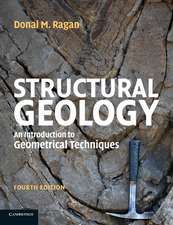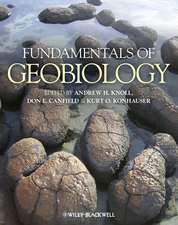The Indian Mesozoic Chronicle: Sequence Stratigraphic Approach: Springer Geology
Autor Jai Krishnaen Limba Engleză Hardback – 21 mar 2017
The Indian Late Precambrian – Neogene record is organized into five mega-sequences. Among these, the fourth – also the most important one – includes the intra-Permian to Early Eocene interval from the origin to the closure of the Neotethys. Based on multidisciplinary integration of the Indian Mesozoic geological record and comparison with hydrocarbon producing basins on east and west of India, a highly positive scenario of the hydrocarbon source/reservoir sediment perspective is outlined in the book in sequence stratigraphic backdrop as an edifice for future elaborate evaluation.
| Toate formatele și edițiile | Preț | Express |
|---|---|---|
| Paperback (1) | 816.87 lei 38-44 zile | |
| Springer Nature Singapore – 29 iul 2018 | 816.87 lei 38-44 zile | |
| Hardback (1) | 845.44 lei 38-44 zile | |
| Springer Nature Singapore – 21 mar 2017 | 845.44 lei 38-44 zile |
Din seria Springer Geology
- 18%
 Preț: 966.15 lei
Preț: 966.15 lei - 15%
 Preț: 711.12 lei
Preț: 711.12 lei - 18%
 Preț: 1248.02 lei
Preț: 1248.02 lei - 18%
 Preț: 791.88 lei
Preț: 791.88 lei - 18%
 Preț: 944.99 lei
Preț: 944.99 lei - 18%
 Preț: 1136.74 lei
Preț: 1136.74 lei - 15%
 Preț: 658.55 lei
Preț: 658.55 lei - 18%
 Preț: 954.31 lei
Preț: 954.31 lei - 18%
 Preț: 2526.25 lei
Preț: 2526.25 lei - 15%
 Preț: 654.77 lei
Preț: 654.77 lei - 18%
 Preț: 913.44 lei
Preț: 913.44 lei - 18%
 Preț: 1015.23 lei
Preț: 1015.23 lei - 18%
 Preț: 1404.30 lei
Preț: 1404.30 lei - 18%
 Preț: 964.71 lei
Preț: 964.71 lei - 18%
 Preț: 789.65 lei
Preț: 789.65 lei - 18%
 Preț: 948.92 lei
Preț: 948.92 lei - 18%
 Preț: 1127.28 lei
Preț: 1127.28 lei - 18%
 Preț: 1248.02 lei
Preț: 1248.02 lei - 18%
 Preț: 950.84 lei
Preț: 950.84 lei - 24%
 Preț: 1123.96 lei
Preț: 1123.96 lei - 15%
 Preț: 643.16 lei
Preț: 643.16 lei - 18%
 Preț: 972.93 lei
Preț: 972.93 lei - 18%
 Preț: 960.78 lei
Preț: 960.78 lei - 18%
 Preț: 787.47 lei
Preț: 787.47 lei - 18%
 Preț: 723.69 lei
Preț: 723.69 lei - 15%
 Preț: 641.20 lei
Preț: 641.20 lei - 15%
 Preț: 659.85 lei
Preț: 659.85 lei -
 Preț: 390.08 lei
Preț: 390.08 lei - 15%
 Preț: 657.08 lei
Preț: 657.08 lei - 20%
 Preț: 405.91 lei
Preț: 405.91 lei - 23%
 Preț: 876.15 lei
Preț: 876.15 lei - 18%
 Preț: 1246.47 lei
Preț: 1246.47 lei - 24%
 Preț: 946.58 lei
Preț: 946.58 lei - 18%
 Preț: 897.02 lei
Preț: 897.02 lei - 18%
 Preț: 948.29 lei
Preț: 948.29 lei - 18%
 Preț: 954.93 lei
Preț: 954.93 lei - 15%
 Preț: 640.06 lei
Preț: 640.06 lei - 18%
 Preț: 1126.65 lei
Preț: 1126.65 lei - 18%
 Preț: 955.40 lei
Preț: 955.40 lei - 18%
 Preț: 1010.96 lei
Preț: 1010.96 lei - 20%
 Preț: 563.35 lei
Preț: 563.35 lei - 18%
 Preț: 952.72 lei
Preț: 952.72 lei - 18%
 Preț: 945.92 lei
Preț: 945.92 lei - 15%
 Preț: 651.84 lei
Preț: 651.84 lei
Preț: 845.44 lei
Preț vechi: 1112.42 lei
-24% Nou
Puncte Express: 1268
Preț estimativ în valută:
161.77€ • 168.90$ • 133.89£
161.77€ • 168.90$ • 133.89£
Carte tipărită la comandă
Livrare economică 01-07 aprilie
Preluare comenzi: 021 569.72.76
Specificații
ISBN-13: 9789811024764
ISBN-10: 9811024766
Pagini: 325
Ilustrații: LXI, 694 p. 210 illus.
Dimensiuni: 155 x 235 x 47 mm
Greutate: 1.45 kg
Ediția:1st ed. 2017
Editura: Springer Nature Singapore
Colecția Springer
Seria Springer Geology
Locul publicării:Singapore, Singapore
ISBN-10: 9811024766
Pagini: 325
Ilustrații: LXI, 694 p. 210 illus.
Dimensiuni: 155 x 235 x 47 mm
Greutate: 1.45 kg
Ediția:1st ed. 2017
Editura: Springer Nature Singapore
Colecția Springer
Seria Springer Geology
Locul publicării:Singapore, Singapore
Cuprins
1. Introduction and Paleogeographic Context, Previous Work, High Resolution Scale, Magnetochronologic Perspective, Radiometric Scenario, Evolutionary Patterns, Anoxic Events and Igneous Activities During the Mesozoic on the Gondwanian Neotethyan Margin.- 2. Mesozoic Stratigraphic Framework in India With Focus on the Kachchh Jurassic Geological Record.- 3. Outcrop Based Sequence Stratigraphic Studies with Focus on the Kachchh Mesozoic.- 4. Integration of the Micro/Macro Faunal/Floral Data into Ammonoid Stratigraphic Framework.- 5. Applicability of the Developed Sequence Framework on the Gondwanian Tethyan Margin (Gtm) from Arabia to Nw Australia, and Brief Comments on the Hydrocarbon Prospects in the Indian Basins.- 6. Crucial Links Among Evolution, Extensional Tectonics, and Sequence Surfaces.- 7. High Resolution Intra-Basinal to Inter-Regional Geodynamic Chronicle During the Mesozoic in and Around the Gtm.
Notă biografică
Prof. Jai Krishna has more than 50 years of experience in teaching research in Geology. He commenced University teaching and research in 1964, and formally retired in 2011 as Professor and Head, Centre of Advanced Study in Geology, Banaras Hindu University, India. Prof. Krishna completed his Doctoral studies from the University of Lucknow in 1968 and his work is on “the ammonoid bearing Callovian–Albian succession of Jaisalmer”. Prof. Krishna carried out post-doctoral studies at McMaster, Canada, jointly with Prof. Gerd Westermann in 1979, 1982, and 1985 on the Jurassics of Kachchh, Jaisalmer, Spiti, and Kumaon Himalaya. During the 1980s and 1990s, Prof. Krishna travelled extensively across the world as Visiting Professor/Scientist/Fellow, inclusive of the coveted Marie Curie Fellowship of the European Economic Community. He realized collaborative researches, participated and chaired conferences, delivered invited lectures, visited stratigraphic sections, consulted type collectionsin Canada, USA, Argentina, Brazil, France, Germany, Switzerland, Netherland, UK, Spain, Belgium, Italy, Russia, Poland, Austria, Japan, China, Australia, Singapore, Malaysia, Indonesia, Thailand and Myanmar.
His focus has been ammonoid and sequence stratigraphy based applicative Mesozoic geology, biogeography, and integrated dynamics. Prof. Krishna has published about 100 research papers in peer reviewed reputed journals inclusive of Nature, more than 50 alone on the Kachchh Jurassic; developed a highly resolved ammonoid zonal scale in the Kachchh Jurassic; formulated comprehensive 1st to 3rd order sequence stratigraphic framework for the Gondwanian Tethyan Margin in India; Spitiian (Late Permian – Pliensbachian), Kachchhian (Toarcian – Barremian), and Dravidian (Aptian – early Early Eocene) respectively in the north, west, and east sectors. Prof Krishna at present continues to be actively focused on the riddles of the Indian Mesozoics andrelated hydrocarbon exploratory geological aspects.
His focus has been ammonoid and sequence stratigraphy based applicative Mesozoic geology, biogeography, and integrated dynamics. Prof. Krishna has published about 100 research papers in peer reviewed reputed journals inclusive of Nature, more than 50 alone on the Kachchh Jurassic; developed a highly resolved ammonoid zonal scale in the Kachchh Jurassic; formulated comprehensive 1st to 3rd order sequence stratigraphic framework for the Gondwanian Tethyan Margin in India; Spitiian (Late Permian – Pliensbachian), Kachchhian (Toarcian – Barremian), and Dravidian (Aptian – early Early Eocene) respectively in the north, west, and east sectors. Prof Krishna at present continues to be actively focused on the riddles of the Indian Mesozoics andrelated hydrocarbon exploratory geological aspects.
Textul de pe ultima copertă
The book reviews and summarizes the Indian Mesozoic geological evolution in an innovative alternative perspective of sequence stratigraphy. It mainly focuses on the Jurassic interval, but also concisely discusses the preceding Triassic and Cretaceous geological records. The key to the study is primarily held in the recently developed ammonoid based high resolution scales in the Triassic and Jurassic period. The Indian Jurassic record is thus elevated to a high resolution pedestal. The large intra-Jurassic stratigraphic gap in Kachchh, with increase in duration from margin to basin, has been précised in different sections, along with radical revision of its long held interpretation from sub-aerial to sub-marine all over from Arabia to Australia. Other significant gaps are also differentiated into sub-aerial and sub-marine.
The Indian Late Precambrian – Neogene record is organized into five mega-sequences. Among these, the fourth – also the most important one – includes theintra-Permian to Early Eocene interval from the origin to the closure of the Neotethys. Based on multidisciplinary integration of the Indian Mesozoic geological record and comparison with hydrocarbon producing basins on east and west of India, a highly positive scenario of the hydrocarbon source/reservoir sediment perspective is outlined in the book in sequence stratigraphic backdrop as an edifice for future elaborate evaluation.
The Indian Late Precambrian – Neogene record is organized into five mega-sequences. Among these, the fourth – also the most important one – includes theintra-Permian to Early Eocene interval from the origin to the closure of the Neotethys. Based on multidisciplinary integration of the Indian Mesozoic geological record and comparison with hydrocarbon producing basins on east and west of India, a highly positive scenario of the hydrocarbon source/reservoir sediment perspective is outlined in the book in sequence stratigraphic backdrop as an edifice for future elaborate evaluation.
Caracteristici
Provides an innovative sequence stratigraphy based holistic chronicle of the Indian Mesozoic geological evolution at resolution of ~400 ky or multiples Offers a focused study of the Jurassic interval Outlines ammonoid geography, expansion, and migration events to and from the Indian sub-continent during the Jurassic Includes supplementary material: sn.pub/extras














